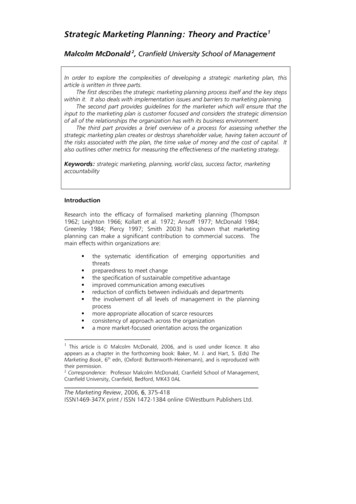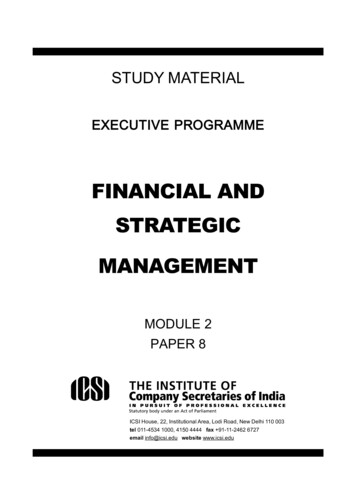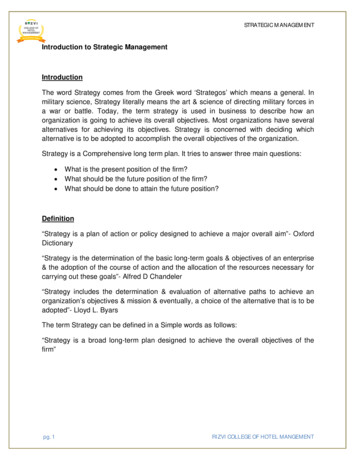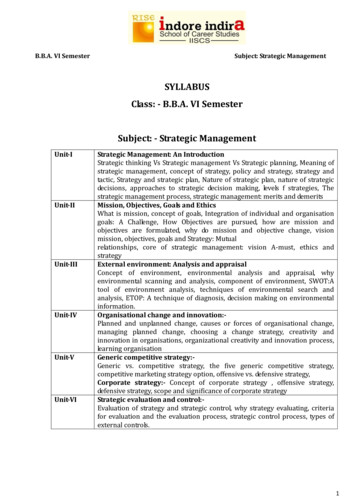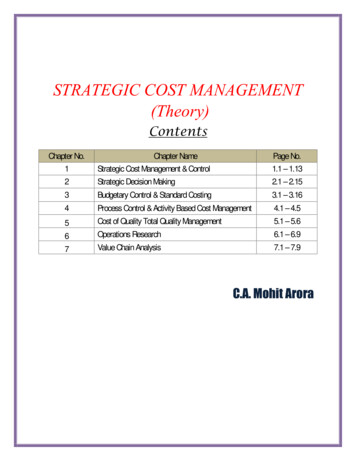
Transcription
STRATEGIC COST MANAGEMENT(Theory)ContentsChapter No.Chapter NamePage No.1Strategic Cost Management & Control1.1 – 1.132Strategic Decision Making2.1 – 2.153Budgetary Control & Standard Costing3.1 – 3.164Process Control & Activity Based Cost Management4.1 – 4.55Cost of Quality Total Quality Management5.1 – 5.66Operations Research6.1 – 6.97Value Chain Analysis7.1 – 7.9C.A. Mohit Arora
Strategic Cost Management CA. Mohit Arora Classes1: STRATEGIC COST MANAGEMENT AND CONTROLTARGET COSTINGMeaning: Target Costing is defined as “a structured approach to determine the cost at which a proposedproduct with specified functionality and quality must be produced, to generate a desired level of profitabilityat its anticipated-selling-price”Steps in Target Costing approach to pricing:1. Setting of target selling price: The setting of target selling price of a product which customers areprepared to pay, depend on many factors like design specifications of the product, competitiveconditions, customer’s demand for increased functionality and higher quality projected productionvolume, sales forecasts etc. A concern can set its target selling price after taking into account all of theaforesaid factors.2. Determination of target costs: Target profit margin may be established after taking into account longterm profit objectives and projected volume of sales. On deducting target profit margin from targetselling price, target cost is determined.3. Estimate the actual cost of the product: Actual cost of the product may be determined after takinginto account the design specifications, material cost and other costs required to produce the product.4. Comparison of estimated cost with actual cost: In case the estimated cost of the product is higherthan that of the target cost of the product then the concern should resort to cost reduction methodsinvolving the use of Value Engineering / Value Analysis tools. (refer complete Value EngineeringProcess in Activity Based Costing)Steps involved in implementing a Target Costing System1. Create a Project Charter: Project Charter is a document, approved by top management that describesits goals and what it is authorized to do. This Charter is based on the corporate mission statement andrelated goals. Written approval of Project Charter by the top management provides the target costingeffort with a strong basis of support and direction in all subsequent efforts.2. Obtain a Management Sponsor: Management Sponsor is an individual belonging to topmanagement. His role will be to support the initiative in all respects, to obtain funding, to coordinate with other members of top management, to eliminate problems in a timely manner.3. Obtain a Budget: The funding should be based on a formal allocation of money through the corporatebudget. The fund should be given unreservedly to the target costing effort.Strategic Cost Management and Control1.1
CA. Mohit Arora Classes Strategic Cost Management4. Assign a Strong Team Manager: The Target Costing Team involves the active participation of manymembers with diverse backgrounds. A strong Team Manager is required to bring the group together asa smooth functioning team focused on key objectives. He should be skilled in dealing withmanagement, the use of project tools and working with a diverse group of people. This managershould be a full-time employee, so that his or her complete attention can be directed towards thewelfare of the project.5. Enroll Full-time Participants: It is essential that the members of the team be devoted to it full-timerather than trying to fulfill other commitment elsewhere in the company at the same time. Theyshould have a single focus on ensuring the success of the target- costing program.6. Use Project Management Tools: Target costing can be a highly complex effort especially forhigh-cost products with many features and components. The team should use all available projectmanagement tools, such as Microsoft Project (for tracking the completion of specific tasks), acompany database containing various types of costing information and a variety of product designtools.Advantages of Target Costing:1. Innovation: It reinforces top-to-bottom commitment to process and product innovation and is aimedat identifying issues to be resolved.2. Competitive Advantage: It enables a firm to achieve competitive advantage over other firms in theindustry. The firm, which achieves cost reduction targets realistically, stands to gain in the long run.3. Market Driven Management: It helps to create a company’s competitive future with marketdriven management for designing and manufacturing products that meet the price required formarket success.4. Real Cost Reduction: It uses management control systems to support and reinforce manufacturingstrategies and to identify market opportunities that can be converted into real savings to achieve thebest value rather than simply the lowest cost.Problems with Target Costing1. The development process can be lengthened to a considerable extent since the design team mayrequire a number of design iterations before it can devise a sufficiently low-cost product thatmeets the target cost and margin criteria.2. A large amount of mandatory cost cutting can result in finger-pointing in various parts of thecompany, especially if employees in one area feel they are being called on to provide adisproportionately large part of the savings.3. Representatives from number of departments on the design team can sometimes make it moredifficult to reach a consensus on the proper design.1.2Strategic Cost Management and Control
Strategic Cost Management CA. Mohit Arora ClassesLife Cycle CostingLife cycle costing, aims at cost ascertainment of a product, project etc. over its projected life. It is asystem that tracks and accumulates the actual costs and revenues attributable to cost object from itsinception to its abandonment.Product Life CycleProduct life cycle is a pattern of expenditure, sale level, revenue and profit over the period from new ideageneration to the deletion of product from product range.Product life cycle spans the time from initial R&D on a product to when customer servicing and support isno longer offered for the product. For products like motor vehicles this time span may range from 5 to7 years. For some basic pharmaceuticals, the time span may be 7 to 10 years. In case of cameras,photocopying machines etc. the life is more than 100 years.Phases in product life cycleThe four identifiable phases in the Product Life Cycle are (a) Introduction (b) Growth (c) Maturityand (d) Decline. A comparative analysis of these phases is given below:ParticularsIntroductionPhaseISales Volume Initial stages, hencelowPrices ofHigh levels to coverinitial costs andProductspromotional expenses.Ratio ofHighest, due to effortneeded to informpromotionpotential customers,expenses tolaunch products,Salesdistribute to customersetc.CompetitionNegligible andinsignificantProfitsGrowthIIRise in sales levels atincreasing rates.Retention of highlevel prices except incertain cases*Total expensesremain the same,while ratio is reduceddue to increase insales.MaturityIIIRise in sales levels atdecreasing rates.Prices fall closerto cost, due to effect ofcompetitionRatio reaches anormal % of sales.Such normal %becomes the industrystandard.Entry of a largeFierce Competitionnumber of competitorsNIL due to heavy initial Increase at a rapidcosts.pace.DeclineIVSales level off and thenstart decreasing.Gap betweenprice and cost is furtherreduced.Reduced salespromotional efforts as theproduct is no longer indemand.Starts disappearing dueto withdrawal of productsNormal rate of profits Declining profits due tosince costs and prices price competition, entryare normalized.of new products etc.* In the growth stage, the firm will maintain the prices at the high levels, in order to realise maximumprofits. Price reduction will not be undertaken unless the low prices will lead rise in demand resulting in highprofits.Strategic Cost Management and Control1.3
CA. Mohit Arora Classes Strategic Cost ManagementProduct Life Cycle CostingIt is an approach used to provide a long term picture of product line profitability, feedback on theeffectiveness of life cycle planning cost data to clarify the economic impact of alternatives chose in thedesign, engineering phase etc. It is also considered as a way to enhance the control of manufacturingcosts. The thrust of product life cycle costing is on the distribution of costs among categories changesover the life of the product, as does the potential profitability of a product. Hence it is important to trackand measure costs during each stage of a product’s life cycle.Features / Characteristics Of Product Life Cycle Costing:Product life cycle costing is important due to the following features: Product life cycle costing involves tracing of costs and revenues of each product over severalcalendar periods throughout their entire life cycle. Costs and revenues can be analysed by timeperiods, but the emphasis is on costs and revenue accumulation over the entire life cycle for eachproduct. Product life cycle costing traces research and design and development costs, incurred to individualproducts over their entire life cycles, so that the total magnitude of these costs for each individualproduct can be reported and compared with product revenues generated in later periods. Life cycle costing therefore ensures that costs for each individual product can be reported andcompared with product revenues generated in later periods. Hence, the costs are made more visible.Benefits Of Product Life Cycle Costing:The benefits of product life cycle costing are summarized as follows: The product life cycle costing results in earlier actions to generate revenue or to lower costs thanotherwise might be considered. There are a number of factors that need to the managed in order tomaximize return on a product. Better decisions should follow from a more accurate and realistic assessment of revenuesand costs, at least within a particular life cycle stage. Product life cycle thinking can promote long-term rewarding in contract to short-term profitabilityrewarding.Importance of Product Life Cycle Costing:Product Life Cycle Costing is considered important due to the following reasons:1. Time based analysis: Life cycle costing involves tracing of costs and revenues of each product overseveral calendar periods throughout their life cycle. Costs and revenues can be analysed by time1.4Strategic Cost Management and Control
Strategic Cost Management CA. Mohit Arora Classesperiods. The total magnitude of costs for each individual product can be reported and compared withproduct revenues generated in later periods.2. Overall Cost Analysis: Production costs are accounted and recognized by the routine accountingsystem. However non-production costs like R&D, design, marketing, distribution, customer service etc.are less visible on a product-by-product basis. Product Life Cycle Costing focuses on recognizing bothproduction and non-production cost.3. Pre-production Costs analysis: The development period for R&D and design is long and costly. Ahigh percentage of total product costs may be incurred before commercial production begins. Hence,the company needs accurate information on such costs for deciding whether to continue with the R&Dor not.4. Effective Pricing Decisions: Pricing Decisions, in order to be effective, should include marketconsideration on the one hand and cost considerations on the other. Product Life Cycle Costing andTarget Costing help analyse both these considerations and arrive at optimal price decisions.5. Better Decision Making: Better decisions should follow from a more accurate and realisticassessment of revenues and costs, at least within a particular life cycle stage.6. Long Run Wholistic view: Product life cycle thinking can promote long-term rewarding in contrastto short-term profitability rewarding. It provides an overall framework for considering totalincremental costs over the entire life span of a product, which in turn facilitates analysis of parts of thewhole where cost effectiveness might be improved.7. Life Cycle Budgeting: Life Cycle Budgeting, i.e. Life Cycle Costing with Target Costing principles,facilitates scope for cost reduction at the design stage itself. The Company stands to benefit sincecosts are avoided before they are committed or locked in.8. Review: Life Cycle Costing provides scope for analysis of long term picture of product lineprofitability, feedback on the effectiveness of life cycle planning and cost data to clarify the economicimpact of alternatives chosen in the design, engineering phase etc.KAIZEN COSTINGKaizen Costing refers to the ongoing continuous improvement program that focuses on the reduction ofwaste in the production process, thereby further lowering costs below the initial targets specified during thedesign phase. It is a Japanese term for a number of cost reduction steps that can be used subsequent toissuing a new product design to the factory floor. The initial VE review may not be complete and perfectin all costs aspects. There may be further chances of waste reduction, cost and time reduction andproduct improvement. Such continuous cost reduction technique is call as Kaizen Costing.The review of product costs under the target costing methodology is not reserved just for the period up tothe completion of design work on a new product. On the contrary, there are always opportunities to controlcosts after the design phase is completed, though these opportunities are fewer than during the designphase.Strategic Cost Management and Control1.5
CA. Mohit Arora Classes Strategic Cost ManagementKaizen Costing Process: Activities in kaizen costing include elimination of waste in production,assembly and distribution processes, as well as the elimination of work steps in any of these areas.Thus kaizen costing is really designed to repeat many of the value engineering steps for as long as aproduct is produced, constantly refining the process and thereby stripping out extra costs at each stage.Savings from Kaizen Costing: The cost reductions resulting from kaizen costing are much smaller thanthose achieved with value engineering. But these are still significant since competitive pressures arelikely to force down the price of a product over time, and any possible cost savings allow acompany to still attain its targeted profit margins Mille continuing to reduce cost.Multiple Versions of Products - Continuous Kaizen Costing: Multiple improved versions of productscan be introduced to meet the challenge of gradually reducing costs and prices. The market price ofproducts continues to drop over time, which forces a company to use both target and kaizen costingto reduce costs and retain its profit margin.However, prices eventually drop to the point where margins are reduced, which forces the company todevelop a new product with lower initial cost and for which kaizen costing can again be used tofurther reduce costs. This pattern may be repeated many times as a company forces its costs downthrough successive generations of products.The exact timing to switch to a new product is easy to determine well in advance since the returns fromkaizen costing follow a trend line of gradually shrinking savings. Since prices also follow a predictabledownward track, plotting these two trend lines into the future reveals when a new product version must beready for production.Just In TimeA JIT approach is a collection of ideas and philosophy that streamline a company’s production processactivities to such an extent that waste of all kind viz. material and labour is systematically driven out of theprocess. Just in Time technique enables a company to ensure that it receives products / spare parts /materials from its suppliers on the exact date and at the exact time when they are needed. The stepsinvolved are:a. Supplier Evaluation: The Purchasing Department must evaluate and investigate every supplier andeliminate those who could not keep up with the delivery dates.b. Supplier Assistance: The engineering staff must visit supplier sites and examine their processes, notonly to see if they can reliably ship high-quality parts but also to provide them with engineeringassistance to bring them up to a higher standard of product.c. Supplier Information System: The firm must install a system, which is as simple as a fax machine oras advanced as an electronic data interchange system or linked computer systems, thatcommunicates with suppliers as to exactly how much of specified parts are to be sent to thecompany.d. Direct Delivery: Deliveries should be sent straight to the production floor for immediate use inmanufactured products, so that no time spent in inspecting the parts for defects. Drivers, whobring supplies of materials, drop them off at the specific machines that will use the materials first.1.6Strategic Cost Management and Control
Strategic Cost Management CA. Mohit Arora ClassesBenefits associated with JIT systemReduction in Inventory levels: Unnecessary piling up of Raw Materials, WIP and finished goods areavoided. The focus is on production and purchase as per the firm’s requirements. Under a JIT system,the amount of inventory retained in a company drops continuously as under: Raw materials inventory is reduced because suppliers deliver only small quantities of parts as andwhen they are needed. Work-in-progress inventory drops because the conversion to machine cells and the use of kanbancards greatly reduces the need to pile up inventory between machines. Finished goods inventory drops because inventories are allowed to build up only if acompany experiences high seasonal sales.Reduction in Wastage of Time: The key focus of any JIT system is on reducing various kinds ofwastage of time, so that the entire production process is concentrated on the time spent in actuallyproducing products. By reducing wastage of time, the firm effectively eliminates activities that do notcontribute to the value of a product which in turn reduces the costs associated with them. Time reductioncan be achieved in the following manager. Inspection Time: All inspection time is eliminated from the system as operators conduct their ownquality cheeks. Suppliers’ assistance and quality checks at supplier’s factory eliminate the need forseparate inspection or QC department in the firm. Handling Time: All movement, which involves shifting inventory and work in process throughoutthe various parts of the plant, can be eliminated by clustering machines together in logical groupingscalled Working Cells Queue Time: Queue time is eliminated by not allowing inventory to build up in front of machines.Kanban cards serve this purpose. Storage Time: Clearing out excessive stocks of inventory and having suppliers deliver parts only asand when needed eliminates Storage time.Reduction in Scrap Rates: There will be sharp reductions in the rates of defectives or scrapped units.The workers themselves identify defects and take prompt action to avoid their recurrence.Reduction in Overhead Costs: Overhead Costs are greatly reduced with JIT operation. This is becauseof the following reasons: Elimination of non value-added activities and improvement in value-added activities. Reduction of timeReduction in Inventory levels and associated costsReduction / Elimination of unnecessary cost driversIntroduction of “Machine Cells” to identify direct costs than overhead expenses.The effect of JIT philosophy on Overhead is three-fold: Thorough reduction in Overhead Costs Shift between Overhead Costs and Direct Costs, due to introduction of Machine Cells Scientific Allocation of common overheads based on Machine Cells and Cost DriversStrategic Cost Management and Control1.7
CA. Mohit Arora Classes Strategic Cost ManagementBy reducing unnecessary (non value-added) activities and the associated time and cost-drivers, overheadscan be greatly reduced e.g. material handling costs, rework costs, facility costs etc.JIT approach for reducing WIP inventoryAt times, there may be huge differences between the operating speeds of different machines. Thisaffects cost in following manner:1. Work-in-process inventory builds up in front of the slowest machines.2. Defective parts produced by an upstream machine may not be discovered until the next downstreammachine operator finds them later. By that time, the upstream machine may have created moredefective parts, all of which must now be destroyed or reworked.In JIT philosophy, there are two ways to resolve the above problems.1. Kanban Card: It is a notification card that a downstream machine sends to each upstream machinethat feeds it with parts, authorizing the production of just enough components to fulfill theproduction requirements. This is also known as “pull” system, since these cards are initiated at the endof the production process pulling work authorizations through the production system. WIP cannot pileup since it can be created only with kanban authorization.2. Working Cells: A Working cell is a small cluster of machines, which can be run by a single machineoperator. The establishment of working cells has the following advantages: The individual machine operator takes each output part from machine to machine within thecell; and thus there is no way for WIP to build up between machines. The operator can immediately identify defective output which otherwise is difficult for eachmachine of the cell. The smaller machines used in a machine cell are generally much simpler thanthe large automated machinery they replace. Hence maintenance costs are reduced. It is much easier to reconfigure the production facility when it is necessary to producedifferent products, avoiding the large expense of carefully repositioning and aligning equipment.What are the performance measures in JITThe following performance measurement criteria are relevant to JIT.1. Inventory turnover: One of the primary objectives of JIT systems is the reduction of unnecessaryinventory. Hence inventory turnover is a suitable performance measure in JIT. This measure canbe subdivided into separate ratios for raw materials, work in process, and finished goods.2. Set up time reduction: The average setup time per machine can be measured periodically and plottedon a trend line. The shortest possible set intervals are crucial for the success of short production runs,so this is a major JIT measurement. It is best to measure it by machine, rather than in the aggregate forall machines.3. Customer complaints: JIT presumes optimum product quality. Hence customer complaints on productproblems should be investigated immediately. The accumulation of customer complaints and theirdissemination to management should be considered a major JIT measure.1.8Strategic Cost Management and Control
Strategic Cost Management CA. Mohit Arora Classes4. Scrap: JIT aims to drive materials scrap rates down to exceedingly low level. The cost of scrap(especially when supported by a detailed list of items that were scrapped) is of particular concern as aJIT system is being implemented, since it helps to identify problem areas requiring further managementattention.5. Cost of quality: One focus of JIT is on creating high-quality products, so it is reasonable to keep trackof the full cost of quality (which comprises defect control costs, failure costs, and the cost of lostsales) on a trend line. Managers want to see the details behind this measure so that they know wherethe largest quality costs still reside in the company and can then work to reduce them.6. Customer service: This measure really has several components like delivering products on the datesrequired by customers shipping full orders to customers, and not having products returnedbecause of poor quality. This measure can be summarized in a variety of ways or reported at thecomponent level, but the main issue is to measure and post the information for all to see, so that thecompany focuses strongly on providing the highest possible degree of customer service.7. Ideas generated: JIT system works best when employees provide suggestions for improvements that,when taken in total result in a vastly improved efficient operation. The amount of idea generation goingon can be measured by the number of ideas per worker, the number of ideas suggested in total,the number of ideas implemented, or the proportion of ideas suggested that are implemented.Backflush CostingTraditional, normal and standard costing systems use the sequential tracking method for accountingcosts. This involves recording journal entries in the same order as transactions occur, i.e. purchase, issueof materials, production, overheads absorption etc. Such systems are required in those manufacturingenvironment where inventory / WIP values are large.An alternative approach to sequential tracking is Backflush Costing. It is a costing system that omitsrecording some or all of the journal entries relating to the cycle from purchase of direct materials to the saleof finished goods. The journal entries for the subsequent stages use normal or standard costs to workbackward to flush out the cost in the cycle for which the journal entries were omitted earlier.Since JIT systems operate in modern manufacturing environment characterized by low inventory and WIPvalues, usually also associated with low cost variances, the use of backflush costing is ideal whencompared to sequential tracking method.However the following issues must be corrected before effective implementation of Backflush Costing:1. Accurate Production reporting: The total production figure entered into the system must beabsolutely correct, or else the wrong component types and quantities will be subtracted from stock.This is a particular problem when there is high turnover or a low level of training to theproduction staff that records this information.2. Proper Scrap reporting: All abnormal scrap must be diligently tracked and recorded. Otherwise,these materials will fall outside the backflushing system and will not be charged to inventory.Since scrap can occur anywhere in a production process, lack of attention by any of the production staffcan result in an inaccurate inventory.Strategic Cost Management and Control1.9
CA. Mohit Arora Classes Strategic Cost Management3. Lot tracing: Lot tracing is impossible under backflushing system. It is required when a manufacturerneed to keep records of which production lots were used to create a product, in case all the items ina lot must be recalled. Only a picking system can adequately record this information. Somecomputer systems allow picking and backflushing system to coexist.4. Inventory accuracy: The inventory balance may be too high at all times because the backflushingtransaction that relieves inventory usually does so only once a day, during which time other inventory issent to the production process. This makes it difficult to maintain an accurate set of inventory records inthe warehouse. The success of backflushing system is directly related to a company’s willingness toinvest in a well-paid, experienced well-educated production staff that undergoes little turnover.Business process re-engineering (Value Engineering)Business process re-engineering involves examining business processes, current operations oforganization and if possible, making substantial changes to current organizational operations. It meansthat apart from segregating all the activities into Value Added and Non Value Added Activities, andeliminating all Non Value added activities from the process, one should also consider, whether there is anybetter way of doing all the value added activities. In value engineering process, we try to find out betterways of doing all the activities so that cost control and cost reduction can be done effectively. For examplepurchase of materials is a business process consisting of activities such as purchase requisition,identifying suppliers, preparing purchase orders, mailing purchase orders and follow up. The process canbe re-engineered by sending the production schedule direct to the suppliers and entering intocontractual agreement to deliver materials according to the production schedule.Some issues analysed during VE review are:1. Elimination of unnecessary functions from the production process: This involves a detailed review of the entire manufacturing process to see if there are any stepsthat add no value to the product, e.g. interim quality review before further processing and final qualitycheck. By eliminating unnecessary or duplicate functions, the firm can reduce their associated direct oroverhead costs from the total product cost. The possible repercussions of elimination of any intermediate production function should be carefullyanalysed. The engineering team must be careful to develop work-around steps that eliminate the needfor the original functions.2. Elimination of unnecessary product qualities: The product quality should be studied with reference to the nature of its use, longevity of product’suseful life. If some unnecessary quality e.g. excessive degree of sturdiness in consumable item (as opposedto a durable item) can be eliminated, it should be done in order to save significant material andother product costs. However, visible reduction in durability or reliability cannot be stretched too far. Hence any designsthat have had their structural integrity reduced must be thoroughly tested to ensure that they meet all1.10Strategic Cost Management and Control
Strategic Cost Management CA. Mohit Arora Classesdesign standards.3. Design Minimisation: This involves the creation of a design that uses fewer parts or has fewer features. This approach is based on the assumption that a minimal design is easier to manufactureand assemble Also, with fewer parts to pur
Strategic Cost Management CA. Mohit Arora Classes Strategic Cost Management and Control 1.1 1: STRATEGIC COST MANAGEMENT AND CONTROL TARGET COSTING Meaning: Target Costing is defined as “a structured approach to determine the cost at which a proposed product with specified functionality and q



